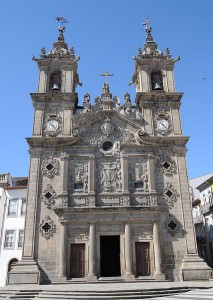Braga is one of the most beautiful and oldest cities in Portugal where past and present can be found side by side.

With a rich heritage dating as far back as the Iron Age and the Celtic era, the city itself was founded by the Romans, who called it Bracara Augusta and made it the capital of the province of Gallaecia and an important trading centre. Traces can still be found in the Citânia de Briteiros and the Fonte do Ídolo Roman fountain.
Invaded by Swabians, Visigoths and later Arabs, the city was successively restructured, religion always playing a pivotal role in its history. There were many and lengthy battles over the city. The archbishopric was restored in 1070.
In the 16th and 17th centuries, buildings of Romanesque origin began to be replaced by new religious architecture and Braga became an important centre for the Baroque style.
Its religious heritage is still very strong in the surrounding landscape. On nearby hills are the Sanctuary of Bom Jesus do Monte and the statue of Nossa Senhora do Monte do Sameiro which appears to bless the city. In the city centre, the Cathedral and the church of Santa Cruz are particularly notable among countless examples of Baroque art. In and around the city we can also find majestic mansions and manor houses that stubbornly recall its important role in the history of Portugal.
Contemporary lifestyles are reflected in the bustle of a university city, where there is still time to enjoy the space and the community.
A way of life that has preserved knowledge and flavours that continue to inspire us.
PLACES TO VISIT :

Cathedral
In the heart of the city is the oldest cathedral in Portugal, which started to be built in 1070. It contains the tombs of Henrique and Teresa, parents of the first king of Portugal.
The combination of contrasting styles – Renaissance, Gothic and Baroque – bear witness to the different periods during which it was built. Among the many treasures in its interior, particularly notable are the organs and choir stalls – exceptional examples of gilt woodcarving.
Church of Santa Cruz
This church was built in the 17th century in the Mannerist-Baroque style. Its monumental stone façade is superbly decorated. Two bell towers with clocks flank a ground-floor portico comprising of four Doric columns and, over the cornice, a blind portico with four Ionic pilasters and richly decorated windows.
Inside, there is a spectacular high-altar retable, three chapels with wonderfully carved altars, as well as an organ and beautiful tile panels.

Sanctuary of Bom Jesus do Monte
Surrounded by lush vegetation, the church overlooks a breathtaking landscape. To visit the hill without taking your car, we recommend the funicular which links Braga to the sanctuary above and is the oldest water-balance funicular railway in the world. At the top, we find one of the most beautiful and important churches in Portugal.
Built between 1784 and 1811, the church was designed by the architect Carlos Amarante and is one of the first neoclassical buildings in the country. Below the church is the zigzag Baroque stairway, with its chapels and wonderful gardens.

